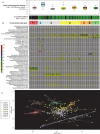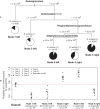Staphylococcus aureus and the ecology of the nasal microbiome
- PMID: 26601194
- PMCID: PMC4640600
- DOI: 10.1126/sciadv.1400216
Staphylococcus aureus and the ecology of the nasal microbiome
Abstract
The human microbiome can play a key role in host susceptibility to pathogens, including in the nasal cavity, a site favored by Staphylococcus aureus. However, what determines our resident nasal microbiota-the host or the environment-and can interactions among nasal bacteria determine S. aureus colonization? Our study of 46 monozygotic and 43 dizygotic twin pairs revealed that nasal microbiota is an environmentally derived trait, but the host's sex and genetics significantly influence nasal bacterial density. Although specific taxa, including lactic acid bacteria, can determine S. aureus colonization, their negative interactions depend on thresholds of absolute abundance. These findings demonstrate that nasal microbiota is not fixed by host genetics and opens the possibility that nasal microbiota may be manipulated to prevent or eliminate S. aureus colonization.
Keywords: Staphylococcus aureus; absolute abundance; competition; human microbiome; interspecies interaction; microbial ecology; microbiome; nares; nasal cavity; nasal microbiome.
Figures



References
-
- van Belkum A., Verkaik N. J., de Vogel C. P., Boelens H. A., Verveer J., Nouwen J. L., Verbrugh H. A., Wertheim H. F. L., Reclassification of Staphylococcus aureus nasal carriage types. J. Infect. Dis. 199, 1820–1826 (2009). - PubMed
-
- Li M., Wang B., Zhang M., Rantalainen M., Wang S., Zhou H., Zhang Y., Shen J., Pang X., Zhang M., Wei H., Chen Y., Lu H., Zuo J., Su M., Qiu Y., Jia W., Xiao C., Smith L. M., Yang S., Holmes E., Tang H., Zhao G., Nicholson J. K., Li L., Zhao L., Symbiotic gut microbes modulate human metabolic phenotypes. Proc. Natl. Acad. Sci. U.S.A. 105, 2117–2122 (2008). - PMC - PubMed
-
- NIH HMP Working Group Peterson J., Garges S., Giovanni M., McInnes P., Wang L., Schloss J. A., Bonazzi V., McEwen J. E., Wetterstrand K. A., Deal C., Baker C. C., Di F. V., Howcroft T. K., Karp R. W., Lunsford R. D., Wellington C. R., Belachew T., Wright M., Giblin C., David H., Mills M., Salomon R., Mullins C., Akolkar B., Begg L., Davis C., Grandison L., Humble M., Khalsa J., Little A. R., Peavy H., Pontzer C., Portnoy M., Sayre M. H., Starke-Reed P., Zakhari S., Read J., Watson B., Guyer M., The NIH Human Microbiome Project. Genome Res. 19, 2317–2323 (2009). - PMC - PubMed
-
- Grice E. A., Kong H. H., Conlan S., Deming C. B., Davis J., Young A. C.; NISC Comparative Sequencing Program Bouffard G. G., Blakesley R. W., Murray P. R., Green E. D., Turner M. L., Segre J. A., Topographical and temporal diversity of the human skin microbiome. Science 324, 1190–1192 (2009). - PMC - PubMed
Grants and funding
LinkOut - more resources
Full Text Sources
Other Literature Sources

